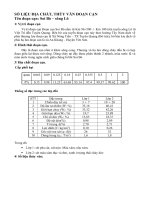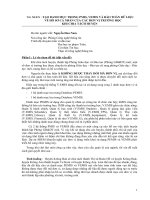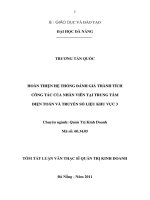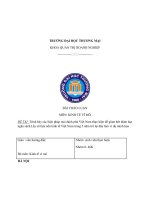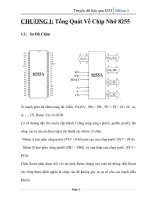Ch10 1 v1 TRUYỀN SỐ LIỆU VÀ MẠNG
Bạn đang xem bản rút gọn của tài liệu. Xem và tải ngay bản đầy đủ của tài liệu tại đây (272.37 KB, 25 trang )
Chapter 10
Error Detection
and
Correction
10.1
Copyright © The McGraw-Hill Companies, Inc. Permission required for reproduction or display.
Note
Data can be corrupted
during transmission.
Some applications require that
errors be detected and corrected.
10.2
10-1 INTRODUCTION
Let us first discuss some issues related, directly or
indirectly, to error detection and correction.
Topics discussed in this section:
Types of Errors
Redundancy
Detection Versus Correction
Forward Error Correction Versus Retransmission
Coding
Modular Arithmetic
10.3
Note
In a single-bit error, only 1 bit in the data
unit has changed.
10.4
Figure 10.1 Single-bit error
10.5
Note
A burst error means that 2 or more bits
in the data unit have changed.
10.6
Figure 10.2 Burst error of length 8
10.7
Note
To detect or correct errors, we need to
send extra (redundant) bits with data.
10.8
Figure 10.3 The structure of encoder and decoder
10.9
Note
In this book, we concentrate on block
codes; we leave convolution codes
to advanced texts.
10.10
Note
In modulo-N arithmetic, we use only the
integers in the range 0 to N −1,
inclusive.
10.11
Figure 10.4 XORing of two single bits or two words
10.12
10-2 BLOCK CODING
In block coding, we divide our message into blocks,
each of k bits, called datawords. We add r redundant
bits to each block to make the length n = k + r. The
resulting n-bit blocks are called codewords.
Topics discussed in this section:
Error Detection
Error Correction
Hamming Distance
Minimum Hamming Distance
10.13
Figure 10.5 Datawords and codewords in block coding
10.14
Example 10.1
The 4B/5B block coding discussed in Chapter 4 is a good
example of this type of coding. In this coding scheme,
k = 4 and n = 5. As we saw, we have 2k = 16 datawords
and 2n = 32 codewords. We saw that 16 out of 32
codewords are used for message transfer and the rest are
either used for other purposes or unused.
10.15
Error Detection
10.16
Enough redundancy is added to
detect an error.
The receiver knows an error
occurred but does not know which
bit(s) is(are) in error.
Has less overhead than error
correction.
Figure 10.6 Process of error detection in block coding
10.17
Example 10.2
Let us assume that k = 2 and n = 3. Table 10.1 shows the
list of datawords and codewords. Later, we will see
how to derive a codeword from a dataword.
Assume the sender encodes the dataword 01 as 011 and
sends it to the receiver. Consider the following cases:
1. The receiver receives 011. It is a valid codeword. The
receiver extracts the dataword 01 from it.
10.18
Example 10.2 (continued)
2. The codeword is corrupted during transmission, and
111 is received. This is not a valid codeword and is
discarded.
3. The codeword is corrupted during transmission, and
000 is received. This is a valid codeword. The receiver
incorrectly extracts the dataword 00. Two corrupted
bits have made the error undetectable.
10.19
Table 10.1 A code for error detection (Example 10.2)
10.20
